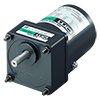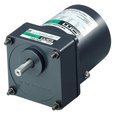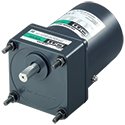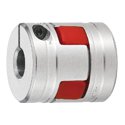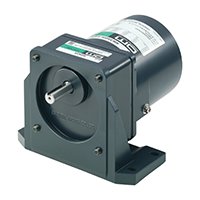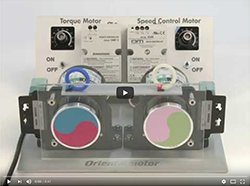World K Series Single-Phase Torque Gear Motors
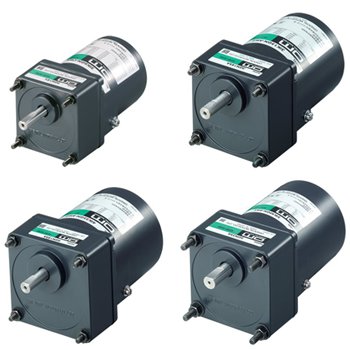
World K Series Single-Phase Torque Gear Motors
Torque motors are designed to provide high starting torque and sloping characteristics (torque is highest at zero speed and decreases steadily with increasing speed), along with operating over a wide speed range. They also provide stable operation, especially in the low speed range or under a locked rotor condition. Available output power of 3 W (1/250 HP) up to 20 W (1/38 HP) with a maximum low speed / stalled rotor torque of 4.97 N-m (88 lb-in.).
For easy torque adjustment, use the TMP-1 Power Controller (sold separately).
- Parallel Shaft Gear or Round Shaft (no Gear)
- Single-Phase 110/115 VAC or Single-Phase 220/230 VAC
AC Gear Motor Lineup
Output Power |
Gear Type |
Power Supply |
Torque at Max Output* |
Motor Speed at Max Output* |
Parallel Shaft Gear |
Single-Phase 110/115 VAC |
0.83 ~ 26 lb-in |
900 r/min (60 Hz) [750 r/min (50 Hz]) |
|
Round Shaft (no Gear) |
5.5 oz-in |
|||
Parallel Shaft Gear |
Single-Phase 110/115 VAC |
1.87 ~ 44 lb-in |
||
Round Shaft (no Gear) |
12.3 oz-in |
|||
Parallel Shaft Gear |
Single-Phase 110/115 VAC |
2.79 ~ 70 lb-in |
||
Round Shaft (no Gear) |
18.4 oz-in |
|||
Parallel Shaft Gear |
Single-Phase 110/115 VAC |
5.59 ~ 88 lb-in |
||
Round Shaft (no Gear) |
36 oz-in |
*Torque and Speed vary based on input voltage and frequency, please review product specifications for details.
Torque Motors

The Speed Can Vary Widely, Depending on the Sloping Characteristics
Torque Motors have a high starting torque and sloping characteristics, allowing easy speed control simply by changing the voltage supplied to the motor. (The motor torque varies in proportion to the square of the voltage).
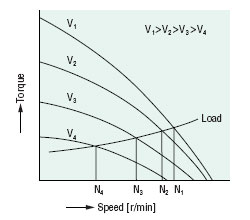
Locked Rotor Operation is Available
Unlike induction motors or reversible motors, torque motors are designed to provide stable torque even under stall conditions or at very low speeds (nearly stalling). They are suitable for pushing applications that require static torque, or for loads that are usually under a locked rotor condition but are under stall conditions at the end of processes. The motors can operate continuously at 60 VAC or less. When used at voltage above 60 VAC, the motors are rated for limited duty. The motor has a 5-minute rating at 115 VAC.
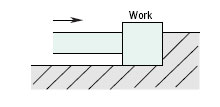
NOTE: When using a motor in a locked rotor condition, the output torque becomes very large. Do not exceed the permissible torque of the gearhead. Also, ensure that the work does not hit an object and stop, since this can cause damage to the gearhead due to shock.
Suitable for Winding Applications
In an application where and object is released continuously at a constant speed and wound up with constant tension, the torque must be doubled and the speed must be halved if the diameter of the winding spool is doubled.
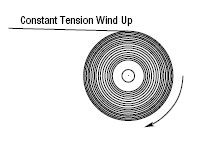
Voltage Control of Torque Motors
The method most commonly used to control voltage is by phase control using a triac. As shown in Fig. 1, by changing the phase angle "alpha" at which the triac switches, the input voltage is controlled as represented by the shaded areas of the graph.
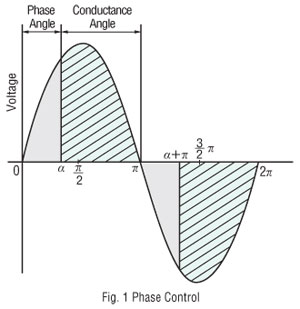
Use as a Brake
By using the motor in the braking region of the speed-torque characteristics, it can serve as a brake. Constant tension operation can be achieved by applying a DC voltage.
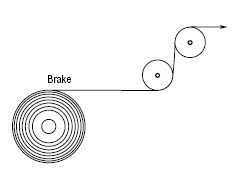
Conforms to Major Safety Standards and Global Power Supply Voltages
Torque Motors are recognized by UL and CSA, and certified under the China Compulsory Certification System (CCC System). CE Marking is used in accordance with the Low Voltage Directive. Also, our wide range of products includes those that meet the power supply voltages of major countries in Asia, North America and Europe.
The Motor Bearing Life is Twice as Long as a Conventional Type
A motor's life is determined by its bearing. We adopted a high-performance bearing grease to lubricate this important component. As a result, the bearings of the motes last twice as long as our conventional bearings.
Protective Earth Terminal on the Motor

Power Controller TMP-1 (Sold Separately)

A new power controller developed for Oriental Motor's torque motors that allows for easy adjustment of torque. A perfect choice for winding applications, push-motion mechanisms and other situations where torque must be adjusted.
Full Range of Functions
- Two torque levels can be set by the internal potentiometer and an external potentiometer/voltage
- Alarm output function (detection of an open thermal protector)
- Instantaneous bi-directional operation by CW/CCW signal switching
- Switching of signal input logic between sink and source
Motor Torque can be adjusted with ease
You can set/adjust motor torque using the internal torque potentiometer of the power controller, etc.
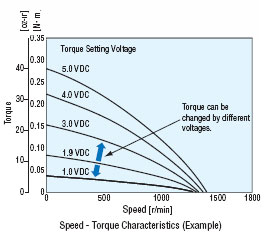
Selectable Torque setting method
Torque can be set using one of three methods according to your needs. You can also change torque between two levels by switching between the internal potentiometer and an external potentiometer/voltage.

How to Use in a Brake Application
A torque motor has the following two characteristic that allow it to be used as a brake:
Reverse-phase brake: Brake characteristics obtained when AC voltage is applied to the motor and the motor is rotated in the direction opposite to the rotational magnetic field.
Eddy-current brake: Brake characteristics obtained when DC voltage is applied to the motor.
Unlike a brake pack or electromagnetic brake that stop the motor, these reverse-phase brake and eddy-current brake characteristics are suited for winding mechanisms and other applications where tension (back-tension) control is required.
Application as a Reverse-Phase Brake
When a torque motor is used as a reverse-phase brake, connect the motor according to the connection diagram and apply AC voltage.
The motor operates at a speed balanced with the load according to the speed-torque characteristics, when the motor is not receiving any force that turns it in the direction opposite to the rotational magnetic field.
To use a torque motor as a brake, force the motor to rotate in the direction opposite to the rotational magnetic field at a torque greater than the starting torque of the motor. Then the torque motor in the direction opposite to the rotational magnetic field while generating a certain brake force.
Fig. 2 shows an example of speed-brake torque characteristics. When a reverse-phase brake is used, a large brake force can be obtained at the speed of 0 r/min. The reverse-phase brake is suitable for applications where tension force is required even when the motor is at standstill.
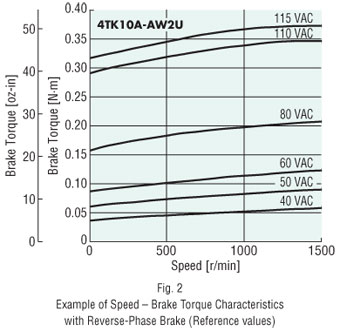
Application as an Eddy-Current Brake
When a torque motor is used as an eddy-current brake, connect the red and white lead wires of the torque motor in series, as shown in Fig. 3, and apply DC voltage. At this time, insulate the black lead wire so that it will not contact any other part of the circuit.
Fig 4. shows an example of speed - brake torque characteristics. the brake torque varies depending on the applied voltage and speed. When the speed is 0 r/min, the brake torque becomes 0 oz-in (0 N·m). the brake torque increases as the speed increases and stabilizes once the speed reaches a certain high level. A similar brake force can also be achieved whether the motor is rotating in the forward or reverse direction. An eddy-current brake is suitable for applications where tension force is required for high-speed operations or at bi-directional operations.
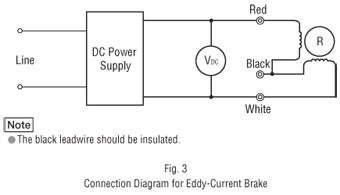
When a torque motor is used as a brake, continuous operating time varies depending on the specific conditions. If a torque motor is combined with a gearhead, keep the speed to 2400 r/min or below.

Power Controller
A power controller developed for Oriental Motor's torque motors that allows for easy adjustment of torque. A perfect choice for winding applications, push-motion mechanisms and other situations where torque must be adjusted.
- Torque can be set using one of three methods; internal potentiometer, external potentiometer or external DC voltage
- Change between two levels by switching between the internal potentiometer and an external potentiometer/voltage
- Alarm output function
- Instantaneous bi-directional operation by CW/CCW signal switching
- Switching of signal input logic between sink and source
Capacitor Connector Lead Wires (5 Sets)
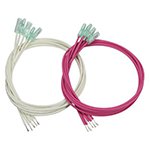
Lead wire set for AC motor capacitors.
- 5 sets 1 part number = 5 sets (10 lead wires). 5 White / 5 Red
- Be sure to use capacitor cover
System Configuration
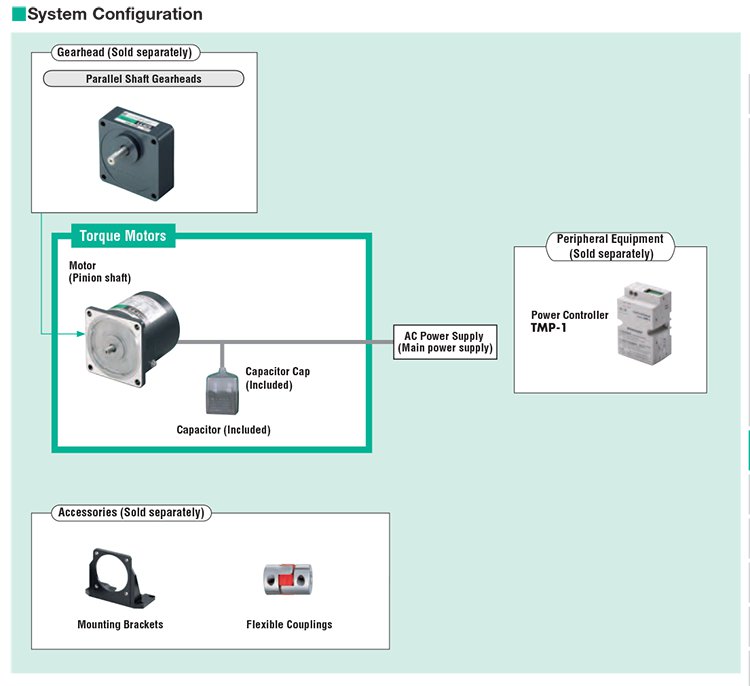
CAD / Manual Search
To locate product CAD and Operator Manuals please search using the product Item Number.
Downloads
Videos
Technical Articles
Reference

